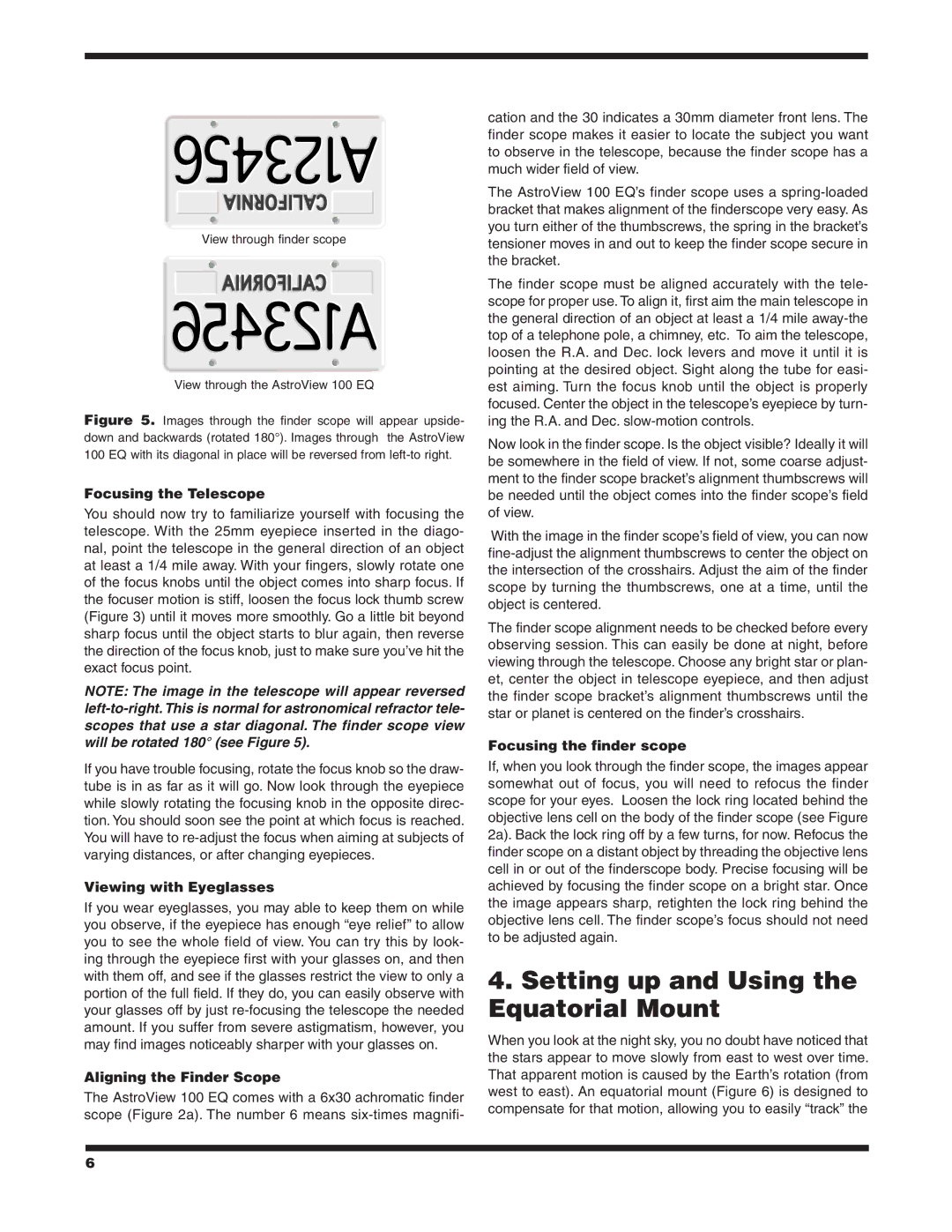
View through finder scope
View through the AstroView 100 EQ
Figure 5. Images through the finder scope will appear upside- down and backwards (rotated 180°). Images through the AstroView 100 EQ with its diagonal in place will be reversed from left-to right.
Focusing the Telescope
You should now try to familiarize yourself with focusing the telescope. With the 25mm eyepiece inserted in the diago- nal, point the telescope in the general direction of an object at least a 1/4 mile away. With your fingers, slowly rotate one of the focus knobs until the object comes into sharp focus. If the focuser motion is stiff, loosen the focus lock thumb screw (Figure 3) until it moves more smoothly. Go a little bit beyond sharp focus until the object starts to blur again, then reverse the direction of the focus knob, just to make sure you’ve hit the exact focus point.
NOTE: The image in the telescope will appear reversed
If you have trouble focusing, rotate the focus knob so the draw- tube is in as far as it will go. Now look through the eyepiece while slowly rotating the focusing knob in the opposite direc- tion. You should soon see the point at which focus is reached. You will have to
Viewing with Eyeglasses
If you wear eyeglasses, you may able to keep them on while you observe, if the eyepiece has enough “eye relief” to allow you to see the whole field of view. You can try this by look- ing through the eyepiece first with your glasses on, and then with them off, and see if the glasses restrict the view to only a portion of the full field. If they do, you can easily observe with your glasses off by just
Aligning the Finder Scope
The AstroView 100 EQ comes with a 6x30 achromatic finder scope (Figure 2a). The number 6 means
cation and the 30 indicates a 30mm diameter front lens. The finder scope makes it easier to locate the subject you want to observe in the telescope, because the finder scope has a much wider field of view.
The AstroView 100 EQ’s finder scope uses a
The finder scope must be aligned accurately with the tele- scope for proper use. To align it, first aim the main telescope in the general direction of an object at least a 1/4 mile
Now look in the finder scope. Is the object visible? Ideally it will be somewhere in the field of view. If not, some coarse adjust- ment to the finder scope bracket’s alignment thumbscrews will be needed until the object comes into the finder scope’s field of view.
With the image in the finder scope’s field of view, you can now
The finder scope alignment needs to be checked before every observing session. This can easily be done at night, before viewing through the telescope. Choose any bright star or plan- et, center the object in telescope eyepiece, and then adjust the finder scope bracket’s alignment thumbscrews until the star or planet is centered on the finder’s crosshairs.
Focusing the finder scope
If, when you look through the finder scope, the images appear somewhat out of focus, you will need to refocus the finder scope for your eyes. Loosen the lock ring located behind the objective lens cell on the body of the finder scope (see Figure 2a). Back the lock ring off by a few turns, for now. Refocus the finder scope on a distant object by threading the objective lens cell in or out of the finderscope body. Precise focusing will be achieved by focusing the finder scope on a bright star. Once the image appears sharp, retighten the lock ring behind the objective lens cell. The finder scope’s focus should not need to be adjusted again.
4.Setting up and Using the Equatorial Mount
When you look at the night sky, you no doubt have noticed that the stars appear to move slowly from east to west over time. That apparent motion is caused by the Earth’s rotation (from west to east). An equatorial mount (Figure 6) is designed to compensate for that motion, allowing you to easily “track” the
6
